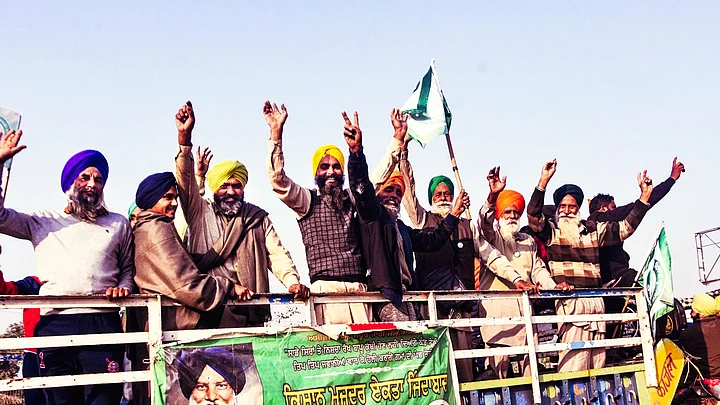This account is based on my visit to the Singhu Border, which is located in the north of Delhi and was the site for a year-long, non-violent struggle by the farmers from Punjab, Haryana and Uttar Pradesh. The place I live and work at, Sonipat, is located here, and due to the farmers' protest – which ended recently after the Centre repealed the three contentious farm laws and agreed to farmers’ demands – entry to Delhi had been blocked since 26 November 2020.
While official accounts say that the farmers had blocked the road, the truth is that the Central government had actually stopped them from reaching the centre of New Delhi, and, more specifically, the Jantar Mantar, which is at the doorstep of the Indian Parliament. But what struck me was the entrance to Delhi, which had been fortified by the government with concrete barriers draped with razor wire. This was the very route that I had taken hundreds of times since I started working in Sonipat, where my university is located.
Anyone who is travelling to Punjab, which evokes the confluence of five rivers, is told that they should visit Amritsar, and more specifically, the Jallianwala Bagh, where the British gunned down peaceful protesters in 1919. For me, visiting the Delhi-Haryana border at Singhu had evoked a similar feeling as I saw, first-hand, a peaceful protest by farmers that stared down the might of the Indian police state.
Sturdy Tents, Langars
The first thing that I noticed is that the protesters had utilized the tractor trolleys and makeshift bamboo houses in an organised way, so that they could seek protection against biting cold, extreme sun and incessant rains. One notable feature was that each tent was marked with the name of their village or district in Punjab, giving me a feeling as if I was making a quick tour stop of Punjab. These tents stretched around 12 kilometres, reaching the border of Delhi, where symbolically, the Guru Tegh Bahadur Memorial is also located.
Apart from shelter, these farmers organised langars, which were supported by the Sikh community from all over India and around the world. At its peak, more than 120 langars were providing food to the protesters and also feeding the poor nearby. These farmers were truly the annadatas to anyone who visited the protest site. In addition to food and shelter, people supporting the protest assisted in starting several field hospitals that provided first aid, medicines, and even critical care to people who fell ill at the site. The Life Care Foundation hospital had over 12 beds with critical care support like ventilators and heart monitors so that they could treat people who suffered heart attacks at the site. They also ran a free medical dispensary so that the farmers could even get regular medications for blood pressure, headaches, fevers and even medical diagnostic tests.
The 'Jangi Kitab Ghar’
Later, during the visit, I came across three small libraries that were started by people participating in the protest. One of them was named the ‘Jangi Kitab Ghar’ (Library of Struggle). This was started by a research scholar from Punjab University, who decided to bring his collection of books so that these peaceful protesters could access thought-provoking material and also reflect on how past struggles could inform current protests. Here, one found books in Punjabi, English, Hindi and even Urdu, which were accessed by different readers. Two books that caught my eye were by Chinese scholars about the history of China and the story of a poor peasant boy.
Of course, the works by Bhagat Singh and about Bhagat Singh found their place in this small library. The library became another space for smaller conclaves and free-wheeling discussions, which reminded me of a thoughtful and academic space like the Jawaharlal Nehru University. The Ambedkar Students’ Association of Punjab University also started a library at the protest site, which issued books on the literature and history of Punjab.
People From Across the Country Participated
I also had the privilege of meeting a native of Hyderabad who was actively participating in these peaceful protests. I found that the protest had seen the participation of people from all walks of life, who participated in waves throughout the last year.
A result of people participating in these protests was a thought-provoking book by Dr Amneet Kaur of Guru Gobind Singh College for Women, titled A Silent Awakening: Power of the Plough. It charts out the search for justice by farmers who were compelled to march to the doorstep of Delhi after the Central government turned a deaf ear to their protests against the farm ordinances and later, Acts in June 2020. She took part in the protest with her family for several months and captured the dynamics of this struggle through photos, poems and the extensive role played by women in the protest.
A final thing that I noticed is that several older protesters, including Gurjeet Kaur, the niece of Shaheed Bhagat Singh, feel proud about their achievement. They feel that their struggle has helped them pass on a heritage to the next generation.
While this government talks in the name of religion, all these farmers credit their victory to god’s grace. This peaceful protest has become part of the folklore of Punjab, and will hopefully become that of India, where people will reminisce about their experience of participating in these protests with pride, unlike the painful memories of Partition that haunt the earlier generations.
(The author teaches Political Science and International Relations at OP Jindal Global University.)
